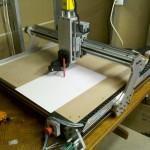After a few tries Shyama and I got the router actually cutting a real part, of our own design! Ok, granted it was a simple part, but its a start. The part, a ClockTHREE stand consists of two end pieces connected by a couple of dowels. It was cut from 1/4 inch plywood. I think it would be really nice out of 1″ hardwood and skip the dowels. Have to see if Angus Hines has any suggestions.
Here is what we learned. In MeshCam, you can define part supports that hold the part in place for the entire cut. Because, as we discovered, the router does not work just as soon as it becomes free from the stock material! It turns out this option is only available from STL generated files. Our first runs from bitmaps were doomed from the start.
We also were seeing some strange cuts until we realized that a “ballmill” bit had been selected rather than an “endmill”. Fixing that also decreased the total cut time.
Here is the tool chain:
- Python to generate OpenScad code
- OpenScad generates STL
- MeshCam generates GCode (ngc)
- EMC2 executes GCode on Router
It works, but may not be the most efficient.
We have a long way to go, but we are making progress!







 – Plug joystick into computer. As configured EMC2 will not run without the joystick plugged in.
– Plug joystick into computer. As configured EMC2 will not run without the joystick plugged in.

